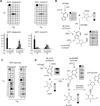Simultaneous tracing of carbon and nitrogen isotopes in human cells
- PMID: 27098229
- PMCID: PMC4879607
- DOI: 10.1039/c6mb00009f
Simultaneous tracing of carbon and nitrogen isotopes in human cells
Abstract
Stable isotope tracing is a powerful method for interrogating metabolic enzyme activities across the metabolic network of living cells. However, most studies of mammalian cells have used (13)C-labeled tracers only and focused on reactions in central carbon metabolism. Cellular metabolism, however, involves other biologically important elements, including nitrogen, hydrogen, oxygen, phosphate and sulfur. Tracing stable isotopes of such elements may help shed light on poorly understood metabolic pathways. Here, we demonstrate the use of high-resolution mass spectrometry to simultaneously trace carbon and nitrogen metabolism in human cells cultured with (13)C- and (15)N-labeled glucose and glutamine. To facilitate interpretation of the complex isotopomer data generated, we extend current methods for metabolic flux analysis to handle multivariate mass isotopomer distributions (MMIDs). We find that observed MMIDs are broadly consistent with known biochemical pathways. Whereas measured (13)C MIDs were informative for central carbon metabolism, (15)N isotopes provided evidence for nitrogen-carrying reactions in amino acid and nucleotide metabolism. This computational and experimental methodology expands the scope of metabolic flux analysis beyond carbon metabolism, and may prove important to understanding metabolic phenotypes in health and disease.
Figures




Similar articles
-
Analysis of carbon and nitrogen co-metabolism in yeast by ultrahigh-resolution mass spectrometry applying 13C- and 15N-labeled substrates simultaneously.Anal Bioanal Chem. 2012 Jun;403(8):2291-305. doi: 10.1007/s00216-012-6009-4. Epub 2012 Apr 29. Anal Bioanal Chem. 2012. PMID: 22543713
-
Ex vivo and in vivo stable isotope labelling of central carbon metabolism and related pathways with analysis by LC-MS/MS.Nat Protoc. 2019 Feb;14(2):313-330. doi: 10.1038/s41596-018-0102-x. Nat Protoc. 2019. PMID: 30683937 Free PMC article.
-
Novel Approach for High-Throughput Metabolic Screening of Whole Plants by Stable Isotopes.Plant Physiol. 2016 May;171(1):25-41. doi: 10.1104/pp.15.01217. Epub 2016 Mar 10. Plant Physiol. 2016. PMID: 26966172 Free PMC article.
-
Historical and contemporary stable isotope tracer approaches to studying mammalian protein metabolism.Mass Spectrom Rev. 2018 Jan;37(1):57-80. doi: 10.1002/mas.21507. Epub 2016 May 16. Mass Spectrom Rev. 2018. PMID: 27182900 Free PMC article. Review.
-
Analysing central metabolism in ultra-high resolution: At the crossroads of carbon and nitrogen.Mol Metab. 2020 Mar;33:38-47. doi: 10.1016/j.molmet.2019.12.002. Epub 2019 Dec 19. Mol Metab. 2020. PMID: 31928927 Free PMC article. Review.
Cited by
-
Chemical Isotope Labeling LC-MS for Metabolomics.Adv Exp Med Biol. 2021;1280:1-18. doi: 10.1007/978-3-030-51652-9_1. Adv Exp Med Biol. 2021. PMID: 33791971
-
Modeling framework for isotopic labeling of heteronuclear moieties.J Cheminform. 2017 Mar 4;9:14. doi: 10.1186/s13321-017-0201-7. eCollection 2017. J Cheminform. 2017. PMID: 28303165 Free PMC article.
-
Deciphering the Metabolic Basis and Molecular Circuitry of the Warburg Paradox in Lymphoma.Cancers (Basel). 2024 Oct 25;16(21):3606. doi: 10.3390/cancers16213606. Cancers (Basel). 2024. PMID: 39518046 Free PMC article.
-
One-shot 13 C15 N-metabolic flux analysis for simultaneous quantification of carbon and nitrogen flux.Mol Syst Biol. 2023 Mar 9;19(3):e11099. doi: 10.15252/msb.202211099. Epub 2023 Jan 27. Mol Syst Biol. 2023. PMID: 36705093 Free PMC article.
-
Profiling the Metabolism of Human Cells by Deep 13C Labeling.Cell Chem Biol. 2018 Nov 15;25(11):1419-1427.e4. doi: 10.1016/j.chembiol.2018.09.004. Epub 2018 Sep 27. Cell Chem Biol. 2018. PMID: 30270114 Free PMC article.
References
Publication types
MeSH terms
Substances
Grants and funding
LinkOut - more resources
Full Text Sources
Other Literature Sources

